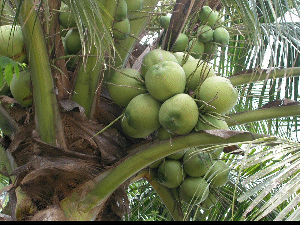


IMPORTANT: The information provided is for information only. The medical claims or advice are not endorsed. Never take any medicines without first consulting a qualified practitioner.

Today, the coconut palm is as valued in the Caribbean as it was 300 years ago. The leaves are used for shelter, the shell for carving, the kernel for food, the oil for medication and cosmetics, and the waste for animal fodder. As a medicine, it’s widely seen as good for the heart and digestion. Boiling up young coconuts with white rum, for example, makes a drink to cure stomach upsets and dysentery.
A coconut is in fact a fruit, with a single seed. There are three layers, one made out of a smooth green outer skin, underneath is a fibrous layer of coir, and lastly the hard dark-brown shell of the seed.
Inside, the seed has firm white flesh (copra) and a sweet liquid ‘milk’ or ‘water’, which thickens with time. Coconut ‘milk’ used in cooking is the grated white flesh mixed with the water. The flesh is eaten fresh, or dried and pressed to release its oil, which is used in shampoos and hair conditioners.
The coir is used to make matting, and is now an important alternative to peat in compost. The hard shell can be used as a cup or container. Sloane was sceptical about island claims that any liquor drunk out of a coconut shell would gain medicinal properties from it.
Some research suggests coconut oil helps with immune problems. It seems to reduce the amount of virus in the body and therefore might be beneficial to HIV and AIDS patients. It also contains anti-microbial chemicals.